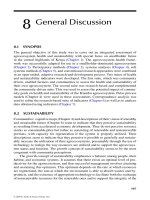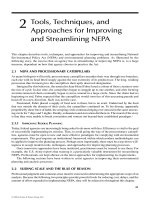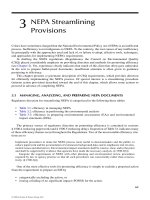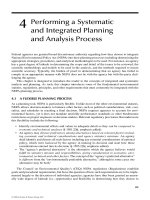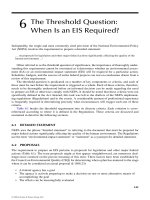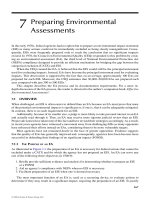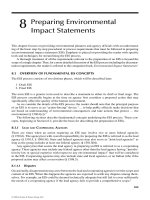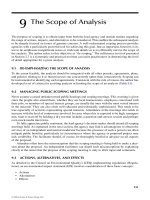Environmental Sampling and Analysis for Metals - Chapter 8 docx
Bạn đang xem bản rút gọn của tài liệu. Xem và tải ngay bản đầy đủ của tài liệu tại đây (114.15 KB, 8 trang )
121
Direct Aspiration or
Flame Atomic Absorption
Spectrometry (FAAS)
8.1 PRINCIPLE
Flame atomic absorption spectrometry is a rapid and precise method of analysis. In this atomic ab-
sorption spectrometry technique (see Section 7.6.1), the sample is vaporized and atomized in a high-
temperature flame. Atoms of the analyte element absorb light of a specific wavelength from a hollow
cathode lamp (HCL), passing through the flame. The amount of energy absorbed by these atoms is
measured and is proportional to the number of atoms in the light path. A light beam is directed
through the flame into a monochromator and onto a detector that measures the amount of light ab-
sorbed by the atomized element in the flame. The amount of energy at the characteristic wavelength
absorbed in the flame is proportional to the concentration of the element in the sample over a limited
concentration range. Table 8.1 shows the FAAS concentration ranges.
Determinations of analyte concentrations in a milligram-per-liter concentration region are routine
for most elements. However, trace metal analyses at microgram-per-liter and nanogram-per-liter levels
are also needed. Because the thermal energy from the flame is responsible for producing the absorbing
species, flame temperature is an important parameter governing the flame process. The two premixed
flames used almost exclusively for atomic absorption are
air–acetylene (2125–2400°C) and nitrous
oxide–acetylene
(2000–2800°C).
While the air–acetylene flame is satisfactory for most elements determined by atomic absorption,
the hotter nitrous oxide–acetylene flame is required for many refractory-forming elements. The ni-
trous oxide–acetylene flame is also effective in the control of some types of interferences.
8.2 DIRECT AIR–ACETYLENE FLAME METHOD
8.2.1 G
ENERAL DISCUSSION
Because the thermal energy from the flame is responsible for producing the absorbing species, flame
temperature is an important parameter governing the flame process. Flames used in the AAS tech-
nique are discussed in Section 7.3.2. The air–acetylene flame is satisfactory for most elements de-
termined by atomic absorption, including Sb, Bi, Cd, Cs, Cr, Co, Cu, Au, Ir, Fe, Pb, Li, Mg, Mn, NI,
Pa, Pt, K, Rh, Ru, Ag, Na, Sr, Ta, Sn, and Zn.
8.2.2 INSTRUMENTATION
See Section 7.3.
8
© 2002 by CRC Press LLC
122 Environmental Sampling and Analysis for Metals
8.2.3 REAGENTS
8.2.3.1 Air
The air used should be cleaned and dried through a suitable filter to remove oil, water, and other for-
eign substances. Sources include a compressor or commercially bottled gas.
8.2.3.2 Acetylene
The acetylene used should be a standard commercial grade. Acetone, which is always present in acety-
lene cylinders, can be prevented from entering and damaging the burner head by replacing a cylinder
TABLE 8.1
Atomic Absorption Concentration Ranges, FAAS Technique
Instrument Optimum
Wavelength Flame Detection Sensitivity Concentration
Element (nm) Gas Limit (mg/l) (mg/l) Range (mg/l)
Ag 328.1 A–Ac 0.01 0.06 0.1–4
Al 309.3 N–Ac 0.1 1 5–50
Au 242.8 A–Ac 0.01 0.25 0.5–20
Ba 553.6 N–Ac 0.03 0.4 1–20
Be 234.9 N–Ac 0.005 0.03 0.05–2
Bi 223.1 A–Ac 0.06 0.4 1–50
Ca 422.8 A–Ac 0.03 0.08 0.2–20
Cd 228.8 A–Ac 0.02 0.025 0.05–2
Co 240.7 A–Ac 0.03 0.2 0.5–10
Cr 357.9 A–Ac 0.02 0.1 0.2–10
Cs 852.1 A–Ac 0.02 0.3 0.5–15
Cu 324.8 A–Ac 0.01 0.1 0.20–10
Fe 248.3 A–Ac 0.02 0.12 0.3–10
Ir 264.0 A–Ac 0.6 8 —
K 766.5 A–Ac 0.005 0.04 0.1–2
Li 670.8 A–Ac 0.002 0.04 0.1–2
Mg 285.2 A–Ac 0.0005 0.007 0.2–2
Mn 279,5 A–Ac 0.01 0.05 0.1–10
Mo 313.3 N–Ac 0.1 0.5 1–20
Na 589.0 A–Ac 0.02 0.015 0.03–1
Ni 232.0 A–Ac 0.02 0.15 0.3–10
Os 290.9 N–Ac 0.08 1 —
Pb
a
283.3 A–Ac 0.05 0.5 1–20
Pt 265.9 A–Ac 0.1 2 5–75
Rh 343.5 A–Ac 0.5 0.3 —
Ru 349.9 A–Ac 0.07 0.5 —
Sb 217.6 A–Ac 0.07 0.5 1–40
Si 251.6 N–Ac 0.3 2 5–150
Sn 224.6 A–Ac 0.8 4 10–200
Sr 460.7 A–Ac 0.03 0.15 0.3–5
Ti 365.3 N–Ac 0.3 2 5–100
V 318.4 N–Ac 0.2 1.5 2–100
Zn 213.9 A–Ac 0.05 0.2 0.05–2
Note: A–Ac = air–acetylene; N–Ac = nitrous oxide–acetylene.
a
The more sensitive 217.0-nm wavelength is recommended for instruments with background correction capabilities.
© 2002 by CRC Press LLC
Direct Aspiration or Flame Atomic Absorption Spectrometry (FAAS) 123
when its pressure has fallen to 689 kPa (100 psi) acetylene. Because of differences among makes and
models of AASs, it is not possible to formulate measurements applicable to every instrument.
8.2.3.3 Metal-Free Water
Use metal-free water for preparing all reagents and calibration standards and as dilution water.
Prepare metal-free water by deionizing and distilling, redistilling, or sub-boiling tap water. Always
check laboratory pure water to determine whether the element of interest is present in trace amounts.
Note: If the source water contains Hg or other volatile metals, single or redistilled water may not
be suitable for trace analysis, because these metals remain in distilled water. In such cases, use sub-
boiling to prepare metal-free water.
8.2.3.4 Stock Metal Solutions
Stock metal solutions are commercially available or can be prepared according to recipes in
Appendix H.
8.2.4 OPERATION
Because of differences among makes and models of AASs, it is not possible to formulate instruc-
tions applicable to every instrument. Follow the manufacturer’s instructions, but in general proceed
as follows:
1. Install hollow cathode lamp for the desired metal.
2. Set wavelength dial as specified by the analytical methodology (see Table 8.1).
3. Set slit width according to manufacturer’s suggested setting.
4. Turn on instrument, apply the hollow cathode lamp current suggested by the manufacturer,
and let the instrument warm up until energy source stabilizes, usually about 10 to 20 min.
5. Readjust current if necessary after warm-up. Adjust wavelength dial until optimum energy
gain is obtained.
6. Align lamp in accordance with manufacturer’s instructions.
7. Install suitable burner head, and adjust its position. A 10-cm, single-slot burner head is
recommended for air–acetylene flames.
8. Turn on air, and adjust flow rate according to manufacturer’s instructions to give maxi-
mum sensitivity for the metal being measured.
9. Turn on acetylene and adjust flow rate to value specified.
10. Ignite flame and let it stabilize for a few minutes.
11. Aspirate blank and zero instrument.
12. Aspirate a standard solution and adjust aspiration rate of nebulizer to obtain maximum
sensitivity.
13. Adjust burner both vertically and horizontally to obtain maximum response.
14. Aspirate blank again and re-zero instrument.
15. Aspirate a standard with a concentration near the middle of the linear range and record
absorbance.
16. The instrument is now ready to operate.
17. When analyses are finished, extinguish flame by turning off acetylene first and then air.
© 2002 by CRC Press LLC
124 Environmental Sampling and Analysis for Metals
8.2.5 STANDARDIZATION
1. Select at least three concentrations of each standard metal solution to bracket expected metal
concentration of sample. (See Table 8.1 for the optimum concentration ranges of metals.)
2. Aspirate blank and zero instrument.
3. Aspirate each standard and record absorbances. Prepare the calibration curve (Section
6.6). For instruments equipped with direct concentration readout, this step is unnecessary.
Preparation of standards and complete calibration processes are discussed in Section 6.6.
Calibrate Ca and Mg based on concentration of standards before dilution with
lanthanum solu-
tion
; Fe and Mn based on original concentration of standards before dilution with calcium solution;
and Cr based on original standards before addition of H
2
O
2
. See methodologies for determining these
metals in Chapter 18.
8.2.6 SAMPLE ANALYSIS
1. Rinse the nebulizer by aspirating water with 1.5 ml of concentrated HNO3/l.
2. Aspirate blank and zero instrument. Analyze samples.
8.2.7 CALCULATIONS
1. Calculate from calibration curve, or read directly from instrument the concentration in
milligrams or micrograms per liter according to calibration.
2. If the sample has been diluted, multiply concentration readout by the appropriate dilution
factor.
3. If the sample has been concentrated, divide concentration readout by appropriate concen-
tration factor.
8.3 DIRECT NITROUS OXIDE–ACETYLENE FLAME METHOD
8.3.1 G
ENERAL DISCUSSION
The hotter nitrous oxide–-acetylene flame (2600–2800°C) is required for many refractory-forming
elements. The nitrous oxide–acetylene flame is also effective in the control of some types of inter-
ference. This method is applicable to the determination of Al, Ba, Be, Mo, Os, Re, Si, Th, Ti, and V.
8.3.2 APPARATUS
Use atomic absorption spectrophotometer and associated equipment. See Section 7.3.
8.3.2.1 Nitrous Oxide Burner Head
Use special burner head as suggested in the manufacturer’s manual. At roughly 20-min intervals of
operation, it may be necessary to dislodge the carbon crust that forms along the slit surface with a
carbon rod or appropriate alternative. Usually a special 5-cm head is required when using a nitrous
oxide–acetylene flame. Burner heads are discussed in Section 7.3.3.
8.3.2.2 T-Junction Valve
Use a T-junction valve or other switching valve for rapidly changing from nitrous oxide to air, so that
the flame can be turned on or off with air as the oxidant to prevent flashbacks.
© 2002 by CRC Press LLC
Direct Aspiration or Flame Atomic Absorption Spectrometry (FAAS) 125
8.3.3 REAGENTS
8.3.3.1 Air
See Section 8.2.3.
8.3.3.2 Acetylene
See Section 8.2.3.
8.3.3.3 Nitrous Oxide
Nitrous oxide is commercially available in cylinders. Fit the nitrous oxide cylinder with a special
nonfreezable regulator, or wrap a heating coil around an ordinary regulator to prevent flashback at
the burner caused by reduction in nitrous oxide flow through a frozen regulator. Some AASs have au-
tomatic gas control systems that will shut down a nitrous oxide flame safely in the event of a reduc-
tion in nitrous oxide flow rate.
8.3.3.4 Metal-Free Water
See Section 8.2.3.
8.3.3.5 Potassium Chloride Solution
Dissolve 250 g of KCl and dilute to 1000 ml with water.
8.3.3.6 Aluminum Nitrate Solution
Dissolve 139 g of Al(NO
3
)
3
.9H
2
O in 150 ml of water. Acidify slightly with concentrated HNO
3
to
prevent hydrolysis and precipitation. Warm to dissolve completely. Cool and dilute to 200 ml.
8.3.3.7 Stock Metal Solutions
These solutions are commercially available or can be prepared according to recipes in Appendix H.
8.3.4 OPERATION
Instrument operation follows the air–acetylene flame method, as discussed in Section 8.2.4. After
steps 1 to 6, proceed as follows:
7. After adjusting wavelength, install a nitrous oxide burner head.
8. Turn on acetylene (without igniting flame) and adjust flow rate according to value speci-
fied by manufacturer for a nitrous oxide–acetylene flame.
9. Turn off acetylene.
10. With both air and nitrous oxide supplies turned on, set T-junction valve to nitrous oxide
and adjust flow rate according to manufacturer’s specifications.
11. Turn switching valve to the air position and verify that the flow rate is the same.
12. Turn acetylene on and ignite to a bright yellow flame.
13. With a rapid motion, turn switching valve to nitrous oxide. The flame should have a red
cone above the burner. If it does not, adjust fuel flow to obtain red cone. After nitrous oxide
flame has been ignited, let burner come to thermal equilibrium before starting analysis.
14. Atomize water containing 1.5 ml of concentrated HNO
3
per liter and check aspiration rate.
Adjust if necessary to a rate between 3 and 5 ml/min.
© 2002 by CRC Press LLC
126 Environmental Sampling and Analysis for Metals
15. Aspirate standard of desired metal with concentration near the midpoint of the optimum
concentration range and adjust burner (both vertically and horizontally) in light path to ob-
tain maximum response. The instrument is ready for analysis.
16. To extinguish flame, turn switching valve from nitrous oxide to air and turn off acetylene.
This procedure eliminates the danger of flashback that may occur on direct ignition or
shutdown of nitrous oxide and acetylene.
8.3.5 STANDARDIZATION
1. Select at least three concentrations of standard metal solution to bracket expected metal
concentration of sample. See Table 8.1 for optimum concentration ranges of metals.
2. Aspirate blank and zero instrument.
3. Aspirate each standard and record absorbances. Prepare calibration curve (Section 6.6).
For instruments equipped with direct concentration readout, this step is unnecessary.
Preparation of standards and complete calibration processes are discussed in Section 6.6.
For 100 ml of Al, Ba, and Ti standards, add 2 ml of KCl solution (dissolve 250 g of KCl and di-
lute to 1000 ml). For 100 ml of Mo and V standards, add 2 ml of Al(NO
3
)
3
.9H
2
O solution. (Dissolve
139 g of Al(NO
3
)
3
.9H
2
O in 150 ml of water, acidify slightly with concentrated HNO
3
, and warm to
dissolve completely. Cool and dilute to 200 ml.)
Most modern instruments are equipped with microprocessors and digital readouts that permit
calibration in the direct concentration range.
8.3.6 ANALYSIS OF SAMPLES
1. After standardization, rinse atomizer by aspirating water with 1.5 ml of concentrated
HNO
3
per liter and zero instrument.
2. Analyze samples. When analyzing Al, Ba, and Ti, add 2 ml of KCl solution to a 100-ml
sample before analysis. When analyzing Mo and V, add 2 ml of Al(NO
3
)
3
solution to a
100-ml sample.
8.3.7 CALCULATIONS
See Section 8.2.7.
8.4 INTERFERENCES, SAFETY, AND QUALITY CONTROL REQUIREMENTS
IN FAAS
See Sections 7.7, 7.8, and 7.9, respectively.
8.5 MAINTENANCE OF FAA SPECTROPHOTOMETER
Maintenance activities for the FAAS are listed in Table 8.2.
8.6 PERFORMANCE CHECK OF FAA SPECTROPHOTOMETER
Performance of the AAS is checked every time a different metal is analyzed. The performance check
is an indicator of deterioration of the lamps or the spectrophotometer and reveals the optimal oper-
ating condition of the instrument. Performance is measured by a “sensitivity check standard” based
© 2002 by CRC Press LLC
Direct Aspiration or Flame Atomic Absorption Spectrometry (FAAS) 127
on a concentration specific to the method for each metal. The absorbance of this standard should be
0.200. If it differs by more than 10%, the instrument is not performing correctly and has to be cor-
rected. Metal concentrations used in performance checks for the FAAS technique are presented in
Table 8.3. Standard conditions for the FAAS technique are summarized in Table 8.4.
TABLE 8.2
Maintenance of FAAS
Maintenance Activity Frequency
Clean bebulizer D
Clean burner head D
Check tubing, pump, and lamps D
Clean quartz windows W
Check electronics SA (I) (C)
Checks optics A (I) (C)
Note: D = daily; W = weekly; SA = semiannually; A = annually; I =
instrumentation specialist; C = on contract.
TABLE 8.3
FAAS Performance Check
Element Concentration of Sensitivity Standard (mg/l)
Aluminum (Al) 50
Antimony (Sb) 25
Barium (Ba) 20
Beryllium (Be) 1.5
Calcium (Ca) at 422.7 nm 4.0
Calcium (Ca) at 287.4 nm 60
Cadmium (Cd) at 228.8 nm 1.5
Cadmium (Cd) at 368.4 nm 850
Cobalt (Co) 7.0
Chromium (Cr) 4.0
Copper (Cu) 4.0
Iron (Fe) 5.0
Lead (Pb) 20
Potassium (K) 2.0
Magnesium (Mg) 0.3
Manganese (Mn) 2.5
Molybdenum (Mo) 30
Nickel (Ni) 7.0
Silicon (Si) 100
Sodium (Na) 0.5
Strontium (Sr) 5.0
Tin (Sn) 150
Titanium (Ti) 80
Thallium (Ta) 30
Tungsten (W) 450
Zinc (Zn) 1.0
Zirconium (Zr) 300
Note: Performance of the FAA should be checked every time a metal is analyzed by
using a sensitivity check standard. The sensitivity check data here pertain to the metal
concentration (mg/l) in aqueous solution, which will give a reading of approximately
0.20 absorbance units.
© 2002 by CRC Press LLC
128 Environmental Sampling and Analysis for Metals
Metal Fuel Oxidant SBW (nm)
Wavelength
(nm)
Optimum
Range (mg/l)
Sensitivity
Check (mg/l)
Detection
Limit (mg/l)
Addition of
Suppressant
Ag Ac–air 0.7 328.1 0.1–4 2.5 0.01
a
Al Ac–N
2
O 0.7 324.7 5–50 50.0 0.1 —
Ba Ac–N
2
O 0.4 553.6 1.0–20 20.0 0.1 2 ml KCL per
100-ml
sample
Be Ac–N
2
O 0.7 234.9 0.05–2 1.5 0.005 —
Cd Ac–air 0.7 228.8 0.05–2 1.5 0.005 —
Ca Ac–N
2
O 0.7 422.7 0.2–7 4.0 0.01 1 ml LaCl
3
per
10-ml sample
Cr Ac–N
2
O 0.7 357.9 0.5–10 4.0 0.05 2 ml KCL per
100-ml
sample
Co Ac–air 0.2 240.7 0.5–5 7.0 0.05 —
Cu Ac–air 0.7 324.7 0.2–5 4.0 0.02 —
Fe Ac–air 0.2 248.3 0.3–5 5.0 0.03 —
KAc–air 1.4 766.5 0.1–2 2.0 0.01
a
Mg Ac–air 0.7 285.2 0.02–0.05 0.3 0.001 1 ml LaCl
3
per
10-ml sample
Mn Ac–air 0.2 279.5 0.1–3 2.5 0.01
a
Mo Ac–N2O 0.2 313.3 1–40 30 0.1 —
Ma Ac–air 0.4 589.0 0.03–1 0.5 0.002
a
Ni Ac–air 0.2 232.0 0.3–5 7.0 0.04 —
Pb Ac–air 0.7 283.3 1–20 20 0.1
a
Sb Ac–air 0.2 217.6 1–40 25 0.2 —
Si Ac–N
2
O 0.2 251.6 — 100 ——
Sn Ac–N
2
O 0,7 286.3 10–300 150 0.8 —
Sr Ac–N
2
O 0.4 460.7 — 5.0 ——
Ti Ac–Air 0.7 276.8 1–20 30 0.1
a
VAc–N
2
O 0.7 318.4 2–200 90 0.2 2 ml Al(NO
3
)
2
per 100-ml
sample
Zn Ac–air 0.7 213.9 0.05–1 1.0 0.005
a
TABLE 8.4
Standard Conditions for Flame AAS
Note: Potassium chloride (KCl) solution: Dissolve 95 g of KCl in analyte-free water and dilute to 1 liter. Lanthanum chloride
(LaCl
3
) solution: Dissolve 29 g of La
2
O
3
in 250 ml of concentrated HCl (be careful, because reaction is violent!), and dilute to
500 ml with analyte-free water. Aluminum nitrate (Al(NO
3
)
2
) solution: Dissolve 139 g of aluminum nitrate nonahydrate
(Al(NO
3
)
2
.9H
2
O) in 150 ml of analyte-free water. Heat. After dissolution, cool to room temperature, and dilute to 200 ml.
Suppressant should be added to the blanks, standards, and samples. Addition of alkali salt is recommended to control ioniza-
tion. Aluminum is added to improve sensitivity and linearity. Lanthanum is added to improve sensitivity.
a
The use of an impact bead will improve sensitivity by about 2%.
© 2002 by CRC Press LLC
